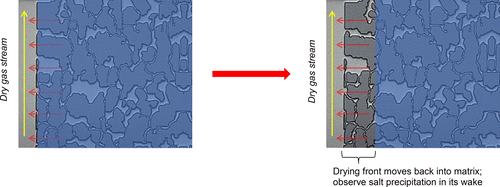当前位置:
X-MOL 学术
›
ACS Earth Space Chem.
›
论文详情
Our official English website, www.x-mol.net, welcomes your
feedback! (Note: you will need to create a separate account there.)
Effect of Wettability Changes on Evaporation Rate and the Permeability Impairment due to Salt Deposition
ACS Earth and Space Chemistry ( IF 2.9 ) Pub Date : 2018-02-14 00:00:00 , DOI: 10.1021/acsearthspacechem.7b00126 Ayorinde Rufai 1 , John Crawshaw 1
ACS Earth and Space Chemistry ( IF 2.9 ) Pub Date : 2018-02-14 00:00:00 , DOI: 10.1021/acsearthspacechem.7b00126 Ayorinde Rufai 1 , John Crawshaw 1
Affiliation

|
Pore-scale visualization was employed to investigate evaporative drying of brine and associated salt deposition at different wetting conditions, using a 2.5D etched-silicon/glass micromodel based on a thin section image of a carbonate rock. We also compared air drying with CO2 drying, with the latter having important applications in CO2 sequestration processes. The resulting permeability impairment was also measured. For deionized water in a water-wet model, we observed the three classical periods of evaporation: the constant rate period (CRP), the falling rate period (FRP), and the receding front period (RFP). The length of the deionized water CRP was much shorter for a uniformly oil-wet model, but mixed wettability made little difference to the drying process. For brine systems at all wetting conditions, the dry area became linear with the square root of time after a short CRP. This is due to the deposited salt acting as a physical barrier to hydraulic connectivity, unlike the case of deionized water, which is due to capillary disconnection from the fracture channel. For the water-wet model, we observed two regions of a linear downward trend in the matrix and fracture permeability measurements. A similar trend was observed for the mixed-wet systems. However, for the oil-wet systems, fracture permeability only changes slightly even for 360 g/L brine, a result of the absence of salt deposits in the fracture caused by the early rupture of the liquid-wetting films needed to aid hydraulic connectivity. Overall, matrix permeability for all wetting conditions decreased with increasing brine concentration and was almost total for the 360 g/L brine. Finally, using CO2 rather than air as carrier gas makes the brine phase more wetting, especially in the deionized water case, with the result that hydraulic connectivity was maintained for longer in the CO2 case compared to dry out with air.
中文翻译:

润湿性变化对盐沉积引起的蒸发速率和渗透性损害的影响
基于碳酸盐岩薄片图像的2.5D蚀刻硅/玻璃微模型,采用孔径可视化技术研究了盐水在不同润湿条件下的蒸发干燥和相关的盐分沉积。我们还将空气干燥与CO 2干燥进行了比较,后者在CO 2中具有重要的应用。隔离过程。还测量了所得的渗透性损害。对于水湿模型中的去离子水,我们观察到三个经典的蒸发时期:恒定速率时期(CRP),下降速率时期(FRP)和后退前沿时期(RFP)。对于均匀油润湿的模型,去离子水CRP的长度要短得多,但是混合润湿性对干燥过程几乎没有影响。对于所有润湿条件下的盐水系统,短暂的CRP后,干燥面积与时间的平方根成线性关系。这是由于沉积的盐对水力连通性起到了物理屏障的作用,这与去离子水的情况不同,这是由于毛细管与裂缝通道的断开所致。对于水湿模型,我们在基质和裂缝渗透率测量中观察到线性下降趋势的两个区域。对于混合湿系统,也观察到了类似的趋势。但是,对于油湿系统,即使对于360 g / L的盐水,裂缝的渗透率也只会略有变化,这是由于裂缝中没有盐沉积,这是由液压连接所需的液体润湿膜的早期破裂引起的。总体而言,所有润湿条件下的基质渗透率均随着盐水浓度的增加而降低,而对于360 g / L盐水而言,其渗透率几乎总计。最后,使用CO 由于液压润湿所需的早期液体润湿薄膜破裂而导致裂缝中没有盐沉积的结果。总体而言,所有润湿条件下的基质渗透率均随着盐水浓度的增加而降低,而对于360 g / L盐水而言,其渗透率几乎总计。最后,使用CO 这是由于液压连接所需的液体润湿膜的早期破裂而导致裂缝中没有盐沉积的结果。总体而言,在所有湿润条件下,基质渗透率都随着盐水浓度的增加而降低,而对于360 g / L盐水而言,其渗透率几乎总计。最后,使用CO2而不是空气作为载气使盐水相更湿润,尤其是在去离子水的情况下,与在空气中变干相比,CO 2情况下的液压连通性可以保持更长的时间。
更新日期:2018-02-14
中文翻译:

润湿性变化对盐沉积引起的蒸发速率和渗透性损害的影响
基于碳酸盐岩薄片图像的2.5D蚀刻硅/玻璃微模型,采用孔径可视化技术研究了盐水在不同润湿条件下的蒸发干燥和相关的盐分沉积。我们还将空气干燥与CO 2干燥进行了比较,后者在CO 2中具有重要的应用。隔离过程。还测量了所得的渗透性损害。对于水湿模型中的去离子水,我们观察到三个经典的蒸发时期:恒定速率时期(CRP),下降速率时期(FRP)和后退前沿时期(RFP)。对于均匀油润湿的模型,去离子水CRP的长度要短得多,但是混合润湿性对干燥过程几乎没有影响。对于所有润湿条件下的盐水系统,短暂的CRP后,干燥面积与时间的平方根成线性关系。这是由于沉积的盐对水力连通性起到了物理屏障的作用,这与去离子水的情况不同,这是由于毛细管与裂缝通道的断开所致。对于水湿模型,我们在基质和裂缝渗透率测量中观察到线性下降趋势的两个区域。对于混合湿系统,也观察到了类似的趋势。但是,对于油湿系统,即使对于360 g / L的盐水,裂缝的渗透率也只会略有变化,这是由于裂缝中没有盐沉积,这是由液压连接所需的液体润湿膜的早期破裂引起的。总体而言,所有润湿条件下的基质渗透率均随着盐水浓度的增加而降低,而对于360 g / L盐水而言,其渗透率几乎总计。最后,使用CO 由于液压润湿所需的早期液体润湿薄膜破裂而导致裂缝中没有盐沉积的结果。总体而言,所有润湿条件下的基质渗透率均随着盐水浓度的增加而降低,而对于360 g / L盐水而言,其渗透率几乎总计。最后,使用CO 这是由于液压连接所需的液体润湿膜的早期破裂而导致裂缝中没有盐沉积的结果。总体而言,在所有湿润条件下,基质渗透率都随着盐水浓度的增加而降低,而对于360 g / L盐水而言,其渗透率几乎总计。最后,使用CO2而不是空气作为载气使盐水相更湿润,尤其是在去离子水的情况下,与在空气中变干相比,CO 2情况下的液压连通性可以保持更长的时间。











































 京公网安备 11010802027423号
京公网安备 11010802027423号